Agree an Ultrasonic cleaner is a must have for mess'in about old bikes. My preferred brew is Deionized water - 3 parts, Simple Green Aircraft Cleaner 1 part, Master Stages 2030 10% Cook @ 40*C for 30 min of Full-Wave & 10 min on De-Gas.





-
Enjoy XS650.com? Consider making a donation to help support the site.
XS650.com receives a small share of sales from some links on this page, but direct donations have a much greater impact on keeping this site going.
You are using an out of date browser. It may not display this or other websites correctly.
You should upgrade or use an alternative browser.
You should upgrade or use an alternative browser.
Ultrasonic Cleaning Thread
- Thread starter 650Skull
- Start date
I don’t know what products are available in Scotland, here I use a 50-50 mix of water and simple green. It’s a non caustic cleaner. And I save the solution and reuse it , I just pour it back in a gallon jug and the sediment settles to the bottom. Note: this does not clean internal passageways, I still use carburetor spray cleaner and shoot that through all the tiny openings , followed by a blast of compressed air.
View attachment 220735View attachment 220736View attachment 220737
They don’t shine like this , straight out of the cleaner. They have a more flat looking appearance, these have been buffed up with a Dremel and assorted brass wire brushes.
Interesting your comment that internal passages aren’t cleaned up by the ultrasonic cleaner. I didn’t know that.
I recycle my cleaning solution too. I just empty my tank into a couple of bottles.
The machine works great for cleaning SS watch bands too. To be safe they should be removed from the watch. Sometimes I get brave and hang onto the case and dip the strap in, one side at a time. Perfect for jewelry too but caution should be exercised if you intend to clean pieces with precious stones. PLEASE do your research first before cleaning gemstones.
Nice one Raymond. I'm about to order the same unit.Resurrecting an old thread. Well, it would seem that the general consensus these days is the best way to clean, for instance, carburetors is an ultrasonic bath. So I have splashed out, so to speak.
View attachment 220725
Six litre bath - about 12 x 6 x 6", the basket is slightly smaller than that, but should be plenty of room for a carb, or pistons, or sundry other engine parts.
Been reading up on solution to use. People like coin collectors seem to go for 50:50 white vinegar and a few drops of wash-up liquid. Some people use water and a spoonful of baking soda. But I've erred on the side of prudence and ordered some carb and machine parts cleaning solution:
View attachment 220726
Stated to be safe on brass, aluminium and other reactive metals. 5 litres, dilute 10:1, should last for ages. Unless I keep thinking of things that need ultrasonic cleaning. Or Mrs does . . .
If you need to use the full size of the bath, remove the wire basket and suspend parts into the solution from a bar straddling the top of the unit.
Don't let the parts stand on the base of the bath as it upsets the sonic performance.
Ads.
Thank you All. A lot of good advice there. Interesting that the ultrasonic cleaner doesn't clean internal passageways - I had thought that was one of the benefits, but never mind. Simple Green seems to be a US product, I think you can buy it here but probably costly on postage? Ads, that's a very good idea hanging items from a bar, seems it's best to have items all separate and not touching the sides or base of the bath.
Interesting that the ultrasonic cleaner doesn't clean internal passageways - I had thought that was one of the benefits
You know I said that without any real proof, I’ve just never trusted a sonic cleaner to break through and remove a hard deposit from inside a tiny passageway. I always believed that they needed to be cleared with a strong carb cleaner spray shooting through a spray straw.
I’d imagine even with carb cleaner it would be beneficial for the cleaner to have some “residence” time in the passage ways to give it a chance to dissolve the deposits. I guess the ultrasonic treatment + carb cleaner + compressed air should get most of the gunk out.You know I said that without any real proof, I’ve just never trusted a sonic cleaner to break through and remove a hard deposit from inside a tiny passageway. I always believed that they needed to be cleared with a strong carb cleaner spray shooting through a spray straw.
If you wanna get real crazy, get some carb dipping solution (like Chemdip) and run that. It’ll clean out all your passage ways and leave it spotless. It’s not cheap but works wonders. The shop I worked at did this.
I soda blast, ultra soak and blow em out. Never had one that didn’t clean up.
I soda blast, ultra soak and blow em out. Never had one that didn’t clean up.
FLEA
XS650 Guru
here in australia what does every one use as a adative , a lot of products suggested here arnt avil here or hard and expensive to get especially in regional areas
Don't have a source of compressed air but your answers have got me musing. Now, should I think about a compressor? What size? Second hand might be an idea? Write a letter to Father Christmas c/o N Pole? Probably not sommat I need or justify.
A compressor's size is, of course dictated by your requirements. To blow-off carbs, the aerosol in spray cans - carb or contact cleaner - is normally sufficient, airing-up tires - a bit more capacity but still small. Larger ones for painting and still larger not needed until you get to media blasting. The sophistication graduates too, filtration, regulators and the like. Battery powered impact wrenches have largely supplanted their air powered counterparts.
https://www.homegearsolution.com/best-air-compressor-uk/
I run a 230LTR, 25CFM with 7.5HP electric motor - it runs many outlets and a blasting cabinet. It's big
https://www.homegearsolution.com/best-air-compressor-uk/
I run a 230LTR, 25CFM with 7.5HP electric motor - it runs many outlets and a blasting cabinet. It's big
Last edited:
Let me first start by saying that I despise impact wrenches, pneumatic engines of thread destruction. Having said that, if your going to wrench on old stuff they are a necessary evil. I have a quite large (80galon) V-twin compressor and 2 pneumatic rattle guns that will shake the house off it's foundation given enough time. But they have been relegated to little more that tire rotating tools and nothing more. My cordless .5" drive DeWalt impact will accomplish 99.9999% of my impact needs with far more precision and delicacy. But a good Proto hand impact is a far better option, much less destructive, and far more effective than any powered impact electric or pneumatic. An air impact is really only good for spinning nuts bolts at a vey high rate of speed and galling threads.Battery powered impact wrenches have largely supplanted their air powered counterparts.
While I don't trust my ultrasonic 100% to clean internal passage in carbs, verification is always necessary. I have had good luck with it doing just that. So far my ultrasonic has done a bang up job getting stubborn crud loose and out most all small internal carburetor passages that I have used it for. But I agree you should always chase em with piano wire (i use old guitar strings) and compressed air or canned air.You know I said that without any real proof, I’ve just never trusted a sonic cleaner to break through and remove a hard deposit from inside a tiny passageway. I always believed that they needed to be cleared with a strong carb cleaner spray shooting through a spray straw.
Don't have a source of compressed air but your answers have got me musing. Now, should I think about a compressor? What size? Second hand might be an idea? Write a letter to Father Christmas c/o N Pole? Probably not sommat I need or justify.
I‘ve never owned a large compressor, I have a small 3 gallon portable. It was inexpensive and it’s easy to store. I use it primarily to air up tires, but it’ll build up 80 lbs of pressure and it works an air nozzle just fine for short bursts, which is all you need for blowing out a carburetor.
ckahleer
XS650 Addict
I found regular Simple Green would turn my carburetors slightly grey, Advanced Simple Green Aircraft does not.
bul_racer
XS650 Addict
Not sure if anyone is still looking at this old thread but I have some questions about ultrasonic cleaners & using them to clean carburetors and jets. I purchased one of these machines from Harbor Freight. Not expensive but not super cheap either. About $90. Thought I'd start with some old corroded jets. So far I've tried plain water; water & ammonia; water, ammonia & white vinegar; water, white vinegar & Dawn dish soap. I also tried putting the jets into a small container filled with gasoline & putting that container in the machine.
Results so far: Zip, Nada, Nothing. So my question is this: have I wasted my $90 on a worthless machine or am I just using the wrong solution?
Oh, the heater works but doesnt get all that hot. I also tried heating water on the stove & putting that into the machine.
Thoughts Anyone?
Results so far: Zip, Nada, Nothing. So my question is this: have I wasted my $90 on a worthless machine or am I just using the wrong solution?
Oh, the heater works but doesnt get all that hot. I also tried heating water on the stove & putting that into the machine.
Thoughts Anyone?
Do you know the actual temperature of the water? My unit has a thermostat controlled heater and I usually run about 140 degrees with Simple Green. The ultrasonic action will bring the temperature up a bit from the set point.
See also the note above about setting things directly on the bottom of the tank. That inhibits the sonics.
See also the note above about setting things directly on the bottom of the tank. That inhibits the sonics.
FLEA
XS650 Guru
were the jets clogged from old fuel , if so the build up maybe to much for it to handle ,iv used tap water and washing detergent and its worked well but jets werent badly clogged , my machine goes up to 60 degs c which is why i operate it from once the water is heated .. also u have to use the wire basket that should have come with it ... have u tried soaking the jets for a week or to first in any form of cleaning solution ... sonic cleaners are good but not merical workersNot sure if anyone is still looking at this old thread but I have some questions about ultrasonic cleaners & using them to clean carburetors and jets. I purchased one of these machines from Harbor Freight. Not expensive but not super cheap either. About $90. Thought I'd start with some old corroded jets. So far I've tried plain water; water & ammonia; water, ammonia & white vinegar; water, white vinegar & Dawn dish soap. I also tried putting the jets into a small container filled with gasoline & putting that container in the machine.
Results so far: Zip, Nada, Nothing. So my question is this: have I wasted my $90 on a worthless machine or am I just using the wrong solution?
Oh, the heater works but doesnt get all that hot. I also tried heating water on the stove & putting that into the machine.
Thoughts Anyone?
I also have an inexpensive Harbour Freight ultra sonic cleaner. I used a 50 / 50 mix of Simple Green and water.
When they first come out of the cleaner, the finish looks clean, but flat. These carbs were cleaned, then I hit them with a Dremel and a wire wheel to bring up the shine. I think ultransonic cleaners are really just for cleaning the gunk off. I still use carburetor spray cleaner with the spray straw to shoot through all the jets and passageways of the carburetor bodies, followed by compressed air. You gotta get those small passageways clean! I then check them by shining a pen light flashlight through them.
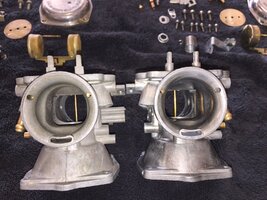
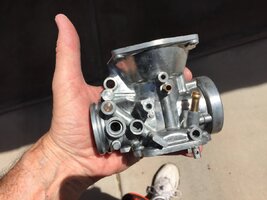
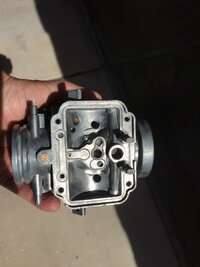
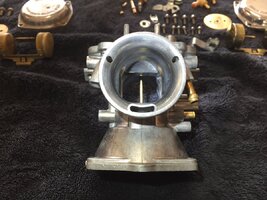
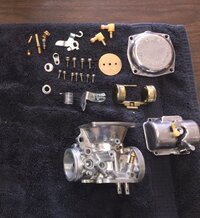
When they first come out of the cleaner, the finish looks clean, but flat. These carbs were cleaned, then I hit them with a Dremel and a wire wheel to bring up the shine. I think ultransonic cleaners are really just for cleaning the gunk off. I still use carburetor spray cleaner with the spray straw to shoot through all the jets and passageways of the carburetor bodies, followed by compressed air. You gotta get those small passageways clean! I then check them by shining a pen light flashlight through them.





I have a gallon of this I've used for cleaning small carb brass for years

It's powerful stuff don't leave jets in it for days...
It may not be available these days.
My small harbor freight sonic cleaner has been used and abused for years, like an energizer bunny it just won't die. Mine has been superceded by a larger 4 tank ultrasonic.
It's powerful stuff don't leave jets in it for days...
It may not be available these days.
My small harbor freight sonic cleaner has been used and abused for years, like an energizer bunny it just won't die. Mine has been superceded by a larger 4 tank ultrasonic.
I have a gallon of this I've used for cleaning small carb brass for years
View attachment 229444
It's powerful stuff don't leave jets in it for days...
It may not be available these days.
My small harbor freight sonic cleaner has been used and abused for years, like an energizer bunny it just won't die. Mine has been superceded by a larger 4 tank ultrasonic.
Just to be clear, you can’t use that chem dip in an ultrasonic cleaner with heat……right?
